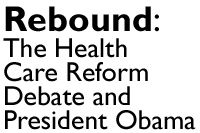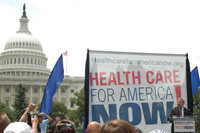







 |
 |
 |
 |
 |
 |
 |
 |
Feature:
Print
Advertising
in
the
President Barack Obama made health care reform a central priority of his administration from the outset, second only to the immediate need to foster an economic recovery. In his Feb. 24, 2009 address to a joint session of Congress, Obama declared, “Health care reform cannot wait, it must not wait, and it will not wait another year.” A Health Care Summit at the White House on March 5 marked the formal start of an historic debate which was to take many twists and turns over the next year.
According
to the Centers for Medicare and Medicaid Services, U.S. health care
spending in
2009 totaled about $2.5 trillion, accounting for 17.3% of the GDP. This
is a
significantly higher share than in other industrialized countries, and
health
care spending is growing at a more rapid rate than the economy as a
whole,
potentially jeopardizing long term financial stability. At the same
time about
16 percent of Americans or between 40 and 45 million are uninsured.
These two
strands—how
to
control
costs
and
how to increase access—defined
the debate of 2009-10.
Debates
over health care have been going on for the better part of a century.
In 1912
Theodore Roosevelt ran for president on a Progressive Party platform
which
called for “a single national health service.” On July 30, 1965
President
Lyndon Johnson signed the legislation creating Medicare and Medicaid. In 1993 the Clinton administration sought to
achieve reform as President Clinton designated First Lady Hillary
Rodham Clinton
to lead the Task Force on National Health Care Reform. The failure of that
effort contributed to
Democrats’ loss of a majority in the House for the first time since
1954. States
have been experimenting with solutions as well. In 2006 Massachusetts
under
Republican Gov. Mitt Romney adopted health care reform legislation
requiring
most residents to have health insurance.
The
issue of health care cuts directly to the question of the proper role
of the
federal government, and vast ideological differences were much on
display as
the debate unfolded in 2009-10. Progressives argued that health care is
a right
and advocated for a single payer system. This idea did not find favor
among
legislators, but the possibility of a public option to compete with
insurers
did have considerable support. By contrast, conservatives said that
America’s
health care system is the best in the world and that free market
solutions can
fix problems the system may have. Critics warned of a government
take-over of
health care as a step towards socialism, foresaw rationing, and said
that in
any case the federal government could not afford to take on the cost of
“Obamacare.” In addition to such questions as whether to include a
public
option and how to pay for reforms without adding to the deficit, other
contentious
issues emerged most notably over language on abortion and coverage for
illegal
immigrants.
Perhaps
mindful of the failure of the Clinton effort, President Obama let
Congress take
the lead on health care reform. Legislation worked its way through
three House
committees and two Senate committees. During the summer of 2009 many
members
held health care town hall meetings, at times contentious. Former Gov.
Sarah
Palin and others even warned of “death panels.” After the heated
summer, President
Obama refocused the debate with his address to a joint session of
Congress on
September 9.
Throughout
the process, Democrats proved unable to attract much if any Republican
support
for their proposals. The most sustained effort was made by Senate
Finance
Committee Chairman Max Baucus (D-MT), but he eventually gave up. Also
in the
Senate, Sen. Ron Wyden (D-OR) worked for a time with Sen. Robert
Bennett (R-UT)
on a proposal. In the House, Rep. Roy Blunt (R-MO) headed up the Health
Care
Solutions Group, and the conservative Republican Study Committee
presented a
proposal in July. As noted by PolitiFact, by late September 2009 more
than 35 Republican
health care reform bills had been introduced advancing such ideas as
tort
reform and allowing consumers to shop across state lines for health
insurance.
On
October 29, House Democrats introduced their bill, H.R. 3962, the
Affordable
Health Care for America Act, at a rally on the west side of the
Capitol. The
House voted on the legislation on Saturday, November 7. The margin
looked
close; President Obama visited Capitol Hill to make a final pitch to
undecided
House Democrats. After a full day of debate, at 11:14 p.m. the House
voted
220-215 to approve H.R. 3962. A late amendment providing restrictions
on
federal funding for abortion was key to passage. Just one Republican,
Rep. Anh
Cao (LA) supported the bill, while 39 Democrats opposed it.
The Senate
process was criticized for a lack of transparency, and the final
legislation did
not include the public option favored by progressives, but did include
a number
of controversial deals such as the “Cornhusker Kickback” and the
“Louisiana
Purchase.” The Senate stayed in session until December 24, before
passing its
version of health care reform by a 60-39 party line vote.
All
looked set for a conference committee early in 2010 until Republican
state Sen.
Scott Brown’s upset win in the January 19 U.S. Senate special election
in
Massachusetts cost Democrats their supermajority. For a time Democrats
were
completely flummoxed, some advocated going to a more modest piecemeal
approach.
Many observers pronounced health care reform dead. Republicans pressed
to
“start over.”
On
February 25 President Obama convened a televised bipartisan meeting on
health
care reform with congressional leaders at Blair House, setting the end
game in
motion. A few days earlier Obama had finally introduced his own
proposal, modeled
fairly closely on the Senate bill. After the bipartisan meeting Obama
pointed
to some areas of agreement with Republicans, but made clear his
intention to
proceed with broader reform. Obama’s rhetoric in this period was
sharply
critical of the health insurance industry.
Congressional
Democrats considered whether to attempt a controversial “deem and pass”
procedure, but decided against it. A vote was set for Sunday March 21.
The
future of Obama’s presidency seemed very much at stake. CBS News
reported that
from March 2009 through the Friday before the vote Obama had delivered
a total
of 54 speeches and statements on health care. On March 20 Obama made
another
trip to Capitol Hill, where he made a final pitch to the House
Democratic
Caucus. The magic number was 216. By the morning of the vote it was
still too
close to call. Abortion remained an issue with the potential to defeat
the
measure, and the White House issued a statement saying Obama would sign
an
executive order clarifying the abortion language. As House Members
debated,
hundreds of tea-partiers gathered outside urging them to “kill the
bill.” That
night, however, the House passed the Patient Protection and
Affordable
Care Act (H.R. 3590) and the
accompanying reconciliation measure, the Health Care and
Education
Reconciliation Act of 2010 (H.R. 4872), by
a margin of 219-212 with all Republicans and 34 Democrats voting
against.
President
Obama signed the legislation on March 23, and the Senate promptly took
up the
reconciliation bill, operating under budget rules which limited debate
to
twenty hours. Senate Republicans managed to find a couple of rules
violations
forcing the reconciliation package back to the House for another vote,
but the
Senate approved the measure by a vote of 56-43, all Republicans and
three
Democrats voting against, and the House followed that evening with a
220-207
vote.
Even as
Obama signed the bill challenges were already in progress. Attorneys
general in
a number of states moved to challenge the constitutionality of the
measure,
particularly the individual mandate requiring citizens to buy health
insurance.
On Capitol Hill some Republican members vowed to repeal the law.
The
result of this sausage making is a far-reaching health insurance reform
measure
which the Congressional Budget Office says will extend health insurance
to 32
million Americans. Balancing the individual mandate are provisions to
address much
criticized practices of the insurance industry. Although some
provisions take
effect immediately, major portions such as the state health insurance
exchanges
and the requirement that insurance companies cover those with
pre-existing
conditions are not set to start until 2014; the excise tax on
“Cadillac” plans
was even put off until 2018.
CBO
estimates that taxes and fees and spending cuts will bring in $1.1
trillion over
ten years to cover the costs of the reform, including limits on the
growth of
Medicare payments and higher Medicare taxes on high income households.
CBO puts
the cost over ten years at $985 billion, primarily to expand Medicaid
and
provide subsidies for private insurance.
Whether
the reforms will do enough to control costs remains to be seen; major
pillars
of the current system such as insurance through employers and fee for
service
remain intact. Even if the reforms survive the challenges, two
thousand-plus
pages of law are bound to entail unintended consequences and to require
adjustments far into the future.
Passage
of the historic health insurance reform legislation did have immediate
political consequences. On the one-year anniversary of his
administration,
President Obama had been seen as floundering and not living up to
expectations.
Comparisons were drawn to Jimmy Carter. New York
(12/07/2009)
asked “Whatever
Happened to Barack Obama?” American
Interest (1/2010) had Obama “Flirting with Failure,” and Newsweek (02/01/2010) described an “Inspiration Gap.”
Just two
months later Obama and the Democrats’ win on health care
put an emphatic stop to those stories.
Timeline
March 25 - Senate
approves the reconciliation package by a vote of 56-43, all Republicans
and three Democrats
voting against, and the House follows that evening with a 220-207 vote.
March 23
- President Obama signs the health insurance reform bill in the East
Room.
March 21
- White House statement saying Obama will sign executive order on
abortion
language. House concurs on Senate
amendments to H.R. 3590, the Patient
March 20
- President Obama makes a last pitch to the House Democratic
Caucus in the
Capitol Visitor Center.
Feb. 25
- Televised Bipartisan Meeting on Health Care Reform at Blair House.
Jan. 19, 2010 -
State Sen. Scott Brown (R) wins the U.S. Senate special election in
Massachusetts, costing the Democrats their supermajority in the Senate.
Dec. 24, 2009
- Senate passes H.R. 3590, Patient Protection and Affordable
Care Act as amended,
by a party line vote of 60-39.
Nov. 7
- House passes the Affordable Health Care for America Act, H.R. 3962,
by a vote
of 220-215, only one Republican voting for.
Oct. 29
- House Democrats introduce their bill, the Affordable Health Care for
America
Act, H.R. 3962, melded together from the three committees’ legislation,
at a
rally on the West side of the Capitol.
Oct. 13
- Senate Finance Committee approves bill.
Sept. 16
- After unsuccessful efforts to gain bipartisan support with Sens.
Grassley, Enzi
and Snowe, Senate Finance Chair Max Baucus releases the chairman’s mark.
Sept. 9
- President Obama delivers a speech on health care to a Joint Session
of
Congress.
July 31
- House Energy and Commerce Committee approves bill.
[July 30
Republican Study Committee chair Tom Price (GA) introduces the
Empowering
Patients First Act].
July 17
- House Ways and Means Committee and House Education and Labor
Committee approve
bills.
July 14
- House Democrats announce America’s Affordable Health Choices Act.
[May 20
Sens. Coburn (OK) and Burr (NC) And Reps. Ryan (WI) and Nunes (CA)
introduce a
Republican bill].
March 5 - Health Care Summit in the East Room of the White House.
March 2
- President Obama nominates Gov. Kathleen Sebelius (D-KS) as his
Secretary of HHS
Feb. 3 - President Obama’s initial pick for Secretary of HHS, former Sen. Majority Leader Tom Daschle, withdraws.